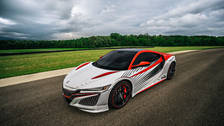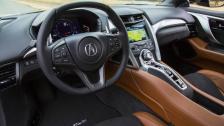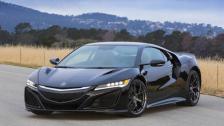Long-awaited Acura NSX is a revolution of power and tech
There aren’t many cars more anticipated than the new Acura NSX. Saying the old car had just a cult following would be doing a disservice to its rabid and massive fan base. Fanboys—still teenagers with posters on their walls when the last NSX bowed–expected a mid engine, expected pure, expected a simple but legendary successor.
The car we ended up getting, though, was a lot different from what the company originally planned. About halfway through the new NSX’s development, Acura engineers decided to change everything.
Acura initially showed the new NSX at the 2012 Detroit auto show—ages ago in car years. At that point, it was basically just a styling exercise, not quite green-lit for production. “It was more yellow-lit,” according to powertrain development leader Keiichi Watanabe. It was a hit, so development ensued. The NSX was always slated as a hybrid, but in 2013, the naturally aspirated V6 became a twin-turbo V6 and the transverse layout went longitudinal, nearly necessitating a clean-sheet design.
The final product, gorgeous and sharp from any angle, arrives in spring with 573 hp and 476 lb-ft, most provided by the mid-mounted V6. The rest comes from the two electric motors sitting back to back on the front axle, driving the front wheels, and the direct-drive motor in back, part of the hybrid system. Power is routed through a paddle-shifted, nine-speed dual-clutch transmission and an all-wheel-drive system Acura now calls Sport Hybrid Super Handling All-Wheel Drive (SH-SH-AWD?). It works with the two electric motors and the mechanical limited-slip differential in the back, allowing all four wheels to be controlled independently.

The NSX connects to the road with an all-aluminum double-wishbone setup in front and a multilink independent rear. Continental tires are standard; Michelin Pilot Super Sports, which performed better but were also noisier, are optional. Magnetic, adjustable dampers at each corner have two settings, adjustable with different drive modes.
A chunky dial in the center of the dash controls the settings, alternating between “quiet,” sport, sport-plus and track driving modes. The digital gauges even do a little twist when you rotate the dial, moving the redline closer to 12 o’clock. The modes control steering ratio, suspension firmness, throttle responsiveness, brake operation and exhaust sound. In quiet and sport, things are dialed back and muffler valves are closed. The intake, engine and exhaust get progressively louder in the more aggressive settings. The NSX can operate under electric power only in quiet and sport, but engine kick-on is noticeably louder than your average hybrid. In sport-plus and track, the engine stays on and the battery is kept charged.
Acura decks out the interior with leather seats and Alcantara inserts (good for keeping you in place around corners), the company’s latest touchscreen infotainment system, and a bunch of chevron styling touches matching the shape of the car’s nose. The dash’s flat surface is a little busy, so in direct sun you see some glare on the windshield. It only became bothersome when dipping in and out of sunlit spots on northern California’s woodsy byways.
Cruising up Highway 1 and the neighboring roads, the NSX felt sticky around the on-camber corners, but compliant enough not to overreact when the roads got a little bumpier. Quiet and sport have one base suspension setting, while sport-plus and track have another. You won’t feel too much difference in front-to-back motion, or heave, as the engineers told us, but those upper modes definitely firmed things up side to side. We will say that even in the stiffest mode, the magnetic dampers didn’t wear us out, even after a long day of driving. Supercars now need to be everything to everyone it seems, and this one is no different. In quiet, you could tool around all day and almost forget you were driving the newest, high-techiest, Japanese exotic.

The central dash is dominated by the drive mode wheel, which switches between quiet, sport, sport plus and track modes.
Forward vision is great with skinny A-pillars and a higher-feeling seating position. It’s not that you sit high—there’s still plenty of room for a helmet—but the dash and hood sort of slope away, leading to good frontal views. It’s not quite as good as the original (we jumped in to compare), which offers one of the widest fields we can remember. Straight rearward vision is clear with the big back window, but backing out of parking spots is a little tougher when trying to look around the giant, blocked-out, flying buttress C-pillar.
We’re not complaining, though, because it looks cool and it helps the car stay cool. The NSX has 10 heat exchangers, with the biggest and most important in the front radiators, twin electric motors and the transmission gear cooler. The air flows in through the front openings, out the wheel-well vents, back into the big side intakes and finally to the intake, turbo intercoolers and engine room. The air flowing over the roof and down the rear hatch is captured to feed the transmission-clutch cooler, while taillight slots manage wake behind the vehicle.
On the track in Sonoma, we were allowed high enough speeds to make sure it worked to keep the car cool; we had no mechanical or overheating problems during a full day of track driving, just one little software hiccup when the NSX wouldn’t upshift after it banged off the rev limiter a few times. We drove the same car later and everything was fine.
Acceleration was immediate with the electric motors, but not brutal, even with launch control engaged. It doesn’t scream like its Italian counterparts or roar like the Americans, the V6 just growls like a dog with its mouth held shut. When the windows are up you hear some turbo whoosh and blow-off, but the exhaust never drones.
At and near the limit, the NSX felt neutral with some understeer if when corners were overcooked. The front-wheel torque pulled the car out of most bad situations and a little throttle retraction brought things back in line if that didn’t work. On the throttle around long sweepers, it had a tendency to wiggle—we could feel the front wheels working to keep the NSX in line. We only experienced oversteer on trail braking, but straight, hard stops from triple digits were drama free.

Six-piston Brembo brakes did most of the work in front with 14.5-inch ceramic discs. The rear gets a four-piston setup and 14-inch plates. We were worried when Acura said they were regenerative, because most of those systems are far from what we’d call “performance-oriented.” Not so here. These brakes are set up to use more fluid as they get hot to maintain a firm pedal feel. We tracked two cars for about five hours with just a hint of fade by day’s end. On the street they were flawless.
The squared-off, carbon-fiber-and-leather steering wheel didn’t bother us as much here as it has in other cars. The quick-acting variable-ratio setup meant we didn’t have to shuffle our hands at all on the track—our fingers stayed on the shift paddles. The paddles are mounted on the wheel as opposed to the column, like they are on some supercars where you can’t hit them if the wheel is turned more than 70 degrees or so.
“Zero delay” was a phrase Acura kept repeating during the drive. Zero delay in braking, turning and acceleration. The company wouldn’t give us straight performance numbers, but it said the NSX was faster to 60 mph than its benchmarks, the Ferrari 458, Porsche 911 Turbo and Audi R8. We can’t say for sure without measuring, but with launch control enabled and electric torque from 0 rpm it felt every bit as fast as those other cheetahs. We probably did about 20 launches in succession, without any warnings from the car or its handlers.
No, it’s not perfect. The big vents in the rear look cool, but we could see debris getting caught there on a long drive. And while the steering is direct, there’s not a lot road feel, though Acura says it did that on purpose to keep the daily drivability high. We’d also ask for a customizable drive mode where we could set the throttle and shifting to track mode with the suspension in its softer setting.
Those are small complaints. After a few days with the modern interpretation of a legend, we accept them with a smile. Acura estimates a $ 155,000 starting price, and it will be exclusive. As for how exclusive, come back on Wednesday and we’ll tell you.
It’s not a spiritual successor to the old car, but it embodies everything Acura’s learned in the 25 years since. Is it as pure an experience? Probably not, but it is everything you want and expect from a Japanese supercar, development time be damned. It was worth the wait.





























